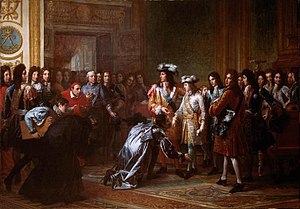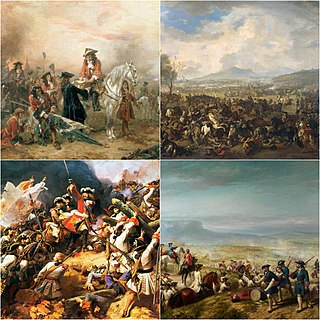
The War of the Spanish Succession was a European great power conflict that took place from 1701 to 1715. Charles II of Spain died in November 1700 without children, leading to a struggle for control of the Spanish Empire. The nominated heir, French-born Philip of Anjou, was primarily backed by Spain and France, while his rival, Archduke Charles, was supported by the Grand Alliance, whose chief members included Austria, the Dutch Republic, and Great Britain. Related conflicts include the 1700 to 1721 Great Northern War, Rákóczi's War of Independence, the Camisards revolt in southern France, Queen Anne's War in North America, and minor trade wars in India and South America.

William III, also widely known as William of Orange, was the sovereign Prince of Orange from birth, Stadtholder of Holland, Zeeland, Utrecht, Guelders, and Overijssel in the Dutch Republic from the 1670s, and King of England, Ireland, and Scotland from 1689 until his death in 1702. As King of Scotland, he is known as William II. He ruled Britain and Ireland alongside his wife, Queen Mary II, and their joint reign is known as that of William and Mary.
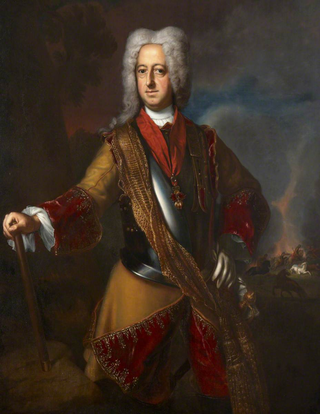
Maximilian II, also known as Max Emanuel or Maximilian Emanuel, was a Wittelsbach ruler of Bavaria and a Prince-elector of the Holy Roman Empire. He was also the last governor of the Spanish Netherlands and Duke of Luxembourg. An able soldier, his ambition led to conflicts that limited his ultimate dynastic achievements.

Leopold I was Holy Roman Emperor, King of Hungary, Croatia, and Bohemia. The second son of Ferdinand III, Holy Roman Emperor, by his first wife, Maria Anna of Spain, Leopold became heir apparent in 1654 after the death of his elder brother Ferdinand IV. Elected in 1658, Leopold ruled the Holy Roman Empire until his death in 1705, becoming the second longest-ruling Habsburg emperor. He was both a composer and considerable patron of music.

Charles II, known as the Bewitched, was the last Habsburg ruler of the Spanish Empire. Best remembered for his physical disabilities and the War of the Spanish Succession that followed his death, Charles' reign has traditionally been viewed as one of managed decline. However, many of the issues Spain faced pre-dated his reign, and some recent historians have suggested a more balanced perspective.

The Peace of Ryswick, or Rijswijk, was a series of treaties signed in the Dutch city of Rijswijk between 20 September and 30 October 1697. They ended the 1688 to 1697 Nine Years' War between France and the Grand Alliance, which included the Dutch Republic and the Holy Roman Empire.

The Nine Years' War (1688–1697), also known as the War of the Grand Alliance or War of the League of Augsburg, was a conflict between France and the Grand Alliance. While concentrated in Europe, fighting spread to the Americas, India, and West Africa, and it has been called the first ever world war. Related conflicts included the Williamite war in Ireland, and King William's War in North America.

The Grand Alliance, sometimes referred to as the League of Augsburg, was formed on 20 December 1689. Signed by William III on behalf of the Dutch Republic and England, and Emperor Leopold I for the Habsburg Monarchy, its primary purpose was to oppose the expansionist policies of Louis XIV of France.
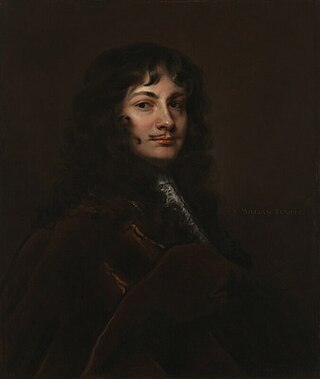
The Triple Alliance was signed by the Kingdom of England, the Swedish Empire and the Dutch Republic in May 1668. It was created in response to the occupation of the Spanish Netherlands and Franche-Comté by France. Although Spain and Emperor Leopold were not signatories, they were closely involved in the negotiations.

The Treaty of London (1700) or Second Partition Treaty was the second attempt by Louis XIV of France and William III of England to impose a diplomatic solution to the issues that led to the 1701-1714 War of the Spanish Succession. Both divided the Spanish Empire without prior consultation and since the Spanish viewed an undivided Empire as non-negotiable, historians generally view them as largely unenforceable.
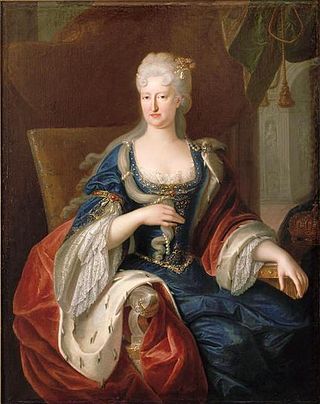
Maria Anna of Neuburg, was a German princess and member of the Wittelsbach family, who became Queen consort of Spain in 1689 as the second wife of Charles II, last Habsburg King of Spain.

The term French–Habsburg rivalry describes the rivalry between France and the House of Habsburg. The Habsburgs headed an expansive and evolving empire that included, at various times, the Holy Roman Empire, the Spanish Empire, Austria, Bohemia and Hungary from the Diet of Augsburg in the High Middle Ages until the dissolution of the monarchy following World War I in the late modern period.
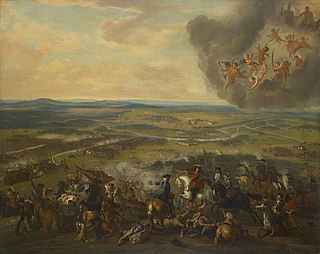
The Battle of Cassano took place on 16 August 1705, during the War of the Spanish Succession, near Cassano d'Adda, in Lombardy, Italy. It was fought between a French army of 22,000 commanded by the duc de Vendôme and an Imperial force of 24,000 under Prince Eugene of Savoy.

The 1698 Treaty of The Hague, also known as the 1698 Treaty of Den Haag or First Partition Treaty was one of two attempts by France, Great Britain, and the Dutch Republic to achieve a diplomatic solution to the issues that led to the 1701–1714 War of the Spanish Succession.

Prince George Louis of Hessen-Darmstadt was a Field Marshal in the Austrian army. He is known for his career in Habsburg Spain, as Viceroy of Catalonia (1698–1701), head of the Austrian army in the War of the Spanish Succession (1701–1705) and governor of Gibraltar in 1704. He was killed during the Siege of Barcelona the following year. He was known in Spanish as Jorge de Darmstadt and in Catalan as Jordi Darmstadt.

After the death of the last Habsburg monarch of Spain in 1700, the childless Charles II, the Spanish throne was up for grabs between various dynasties of Europe despite Charles having left a will naming his heir. In this will, Charles left Philip, Duke of Anjou, grandson of Louis XIV of France, the possessions of the Spanish Crown.
Events from the year 1701 in France.

The imperial election of 1742 was an imperial election held to select the emperor of the Holy Roman Empire. It took place in Frankfurt on January 24. The result was the election of Charles Albert of Bavaria, the first non-Habsburg emperor in hundreds of years.

The Convention of Milan, signed on 13 March 1707 during the War of the Spanish Succession, was an agreement between France and Austria which ended the fighting in Northern Italy. The French were allowed to withdraw their remaining forces undisturbed and in return handed control of any towns they still held to the Austrian commander Prince Eugene of Savoy.
